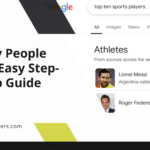
|
Getting your Trinity Audio player ready...
|
The Ultimate SEO Checklist Template is a comprehensive guide that can help bloggers improve their SEO efforts and increase their online visibility. SEO, or search engine optimization, is the practice of optimizing your website and its content to rank higher in search engine results pages (SERPs). By following the steps outlined in this checklist, bloggers can ensure that their content is optimized for search engines and attract more organic traffic to their site.
The checklist covers various aspects of SEO, including keyword research, on-page optimization, off-page optimization, content creation, technical SEO considerations, mobile optimization, and analytics and reporting. By addressing each of these areas, bloggers can create a well-rounded SEO strategy that will improve their blog’s search engine ranking and ultimately drive more traffic to their site.
Key Takeaways
- The Ultimate SEO Checklist Template is a comprehensive guide to optimizing your blog for search engines.
- SEO is crucial for increasing your blog’s online visibility and attracting more traffic.
- Keyword research is the foundation of effective SEO and helps you target the right audience.
- On-page optimization techniques like optimizing titles, meta descriptions, and content can boost your blog’s ranking.
- Off-page optimization strategies like link building and social media can help build your blog’s authority and credibility.
Understanding the Importance of SEO for Your Blog’s Online Visibility
SEO is crucial for bloggers who want to increase their online visibility and attract more traffic to their site. When users search for information or products online, they typically turn to search engines like Google. Studies have shown that the majority of users click on one of the top few results on the first page of search results. Therefore, if your blog doesn’t appear on the first page of search results for relevant keywords, you are missing out on a significant amount of potential traffic.
By implementing effective SEO strategies, bloggers can improve their blog’s search engine ranking and increase their chances of appearing on the first page of search results. This increased visibility can lead to more organic traffic to your site, which can result in higher engagement, more conversions, and ultimately, increased revenue or success for your blog.
Keyword Research: The Foundation of Effective SEO
Keyword research is the foundation of effective SEO. It involves identifying the keywords and phrases that your target audience is using to search for information related to your blog’s niche. By targeting these keywords in your content, you can increase your chances of ranking higher in search engine results for those specific queries.
To conduct keyword research, start by brainstorming a list of relevant topics and themes related to your blog’s niche. Then, use keyword research tools like Google Keyword Planner, SEMrush, or Moz Keyword Explorer to find related keywords and phrases that have high search volume and low competition. Look for long-tail keywords, which are longer and more specific phrases that are easier to rank for.
Once you have identified a list of target keywords, incorporate them naturally into your blog content. Be sure to include them in your title tags, meta descriptions, header tags, and throughout the body of your content. However, avoid keyword stuffing, which is the practice of overusing keywords in an unnatural way. This can actually harm your SEO efforts and result in a penalty from search engines.
On-Page Optimization Techniques for Boosting Your Blog’s Ranking
| Technique | Description | Impact |
|---|---|---|
| Keyword research | Identifying relevant keywords to target in your content | Increases visibility and traffic |
| Title tags | Optimizing the title of your blog post with targeted keywords | Improves click-through rate and search engine ranking |
| Meta descriptions | Writing a concise summary of your blog post for search engines | Increases click-through rate and search engine ranking |
| Header tags | Using H1, H2, and H3 tags to structure your content | Improves readability and search engine ranking |
| Internal linking | Linking to other relevant pages on your blog | Improves navigation and search engine ranking |
| Image optimization | Optimizing images with alt tags and descriptive file names | Improves accessibility and search engine ranking |
| Content length | Creating in-depth, high-quality content | Increases engagement and search engine ranking |
| URL structure | Creating descriptive and readable URLs | Improves user experience and search engine ranking |
On-page optimization refers to the techniques used to optimize individual web pages to improve their search engine ranking. This includes optimizing title tags, meta descriptions, header tags, and other on-page elements.
Title tags are one of the most important on-page elements for SEO. They should be descriptive, concise, and include your target keyword. Meta descriptions are the brief summaries that appear below the title tag in search engine results. They should also be descriptive and include relevant keywords.
Header tags (H1, H2, H3, etc.) are used to structure the content on your web page. They help search engines understand the hierarchy and organization of your content. Include your target keyword in at least one header tag on each page.
Other on-page optimization techniques include optimizing image alt text, using internal linking to connect related pages on your site, and optimizing URL structure. Make sure your URLs are descriptive and include relevant keywords.
Off-Page Optimization Strategies for Building Your Blog’s Authority
Off-page optimization refers to the strategies used to improve your blog’s authority and reputation in the eyes of search engines. This includes link building, social media marketing, and other external factors that can impact your blog’s search engine ranking.
Link building is one of the most important off-page optimization strategies. It involves getting other websites to link to your blog. Search engines view these inbound links as a vote of confidence in your content, which can improve your blog’s authority and search engine ranking. Some effective link building strategies include guest blogging, creating high-quality content that others want to link to, and reaching out to influencers or industry experts for collaborations or partnerships.
Social media marketing is another important off-page optimization strategy. By promoting your blog content on social media platforms like Facebook, Twitter, and Instagram, you can increase its visibility and attract more traffic to your site. Additionally, social signals (such as likes, shares, and comments) can also have a positive impact on your blog’s search engine ranking.
Content Creation Tips for Maximizing Your SEO Efforts

Creating high-quality, SEO-friendly content is essential for improving your blog’s search engine ranking and attracting readers. Here are some tips for maximizing your SEO efforts through content creation:
1. Conduct keyword research: As mentioned earlier, keyword research is crucial for identifying the keywords and phrases that your target audience is using to search for information related to your blog’s niche. Incorporate these keywords naturally into your content to improve its relevance and search engine ranking.
2. Write compelling headlines: Your headline is the first thing readers see when they come across your content in search engine results or on social media. Make sure it is attention-grabbing and includes relevant keywords.
3. Create high-quality, informative content: Your content should provide value to readers by answering their questions or providing solutions to their problems. Aim to create comprehensive, well-researched content that is unique and stands out from the competition.
4. Use subheadings and bullet points: Breaking up your content with subheadings and bullet points makes it easier for readers to scan and digest. It also helps search engines understand the structure and organization of your content.
5. Optimize images: Include relevant keywords in your image alt text and file names. This can help improve your blog’s visibility in image search results.
6. Update and repurpose old content: Regularly updating and repurposing old content can help improve its search engine ranking and attract new readers. Look for opportunities to add new information, update statistics, or repurpose content into different formats (such as videos or infographics).
Technical SEO Checklist: Ensuring Your Blog is Search Engine-Friendly
Technical SEO refers to the optimization of your website’s technical aspects to improve its search engine ranking. Here are some technical SEO considerations to keep in mind:
1. Site speed: A slow-loading website can negatively impact user experience and search engine ranking. Optimize your site’s speed by compressing images, minifying CSS and JavaScript files, and using caching techniques.
2. Mobile-friendliness: With the increasing use of mobile devices, it is essential that your blog is mobile-friendly. Make sure your site is responsive and displays properly on different screen sizes.
3. URL structure: Use descriptive URLs that include relevant keywords. Avoid using long, complex URLs with unnecessary parameters.
4. XML sitemap: Create an XML sitemap for your blog and submit it to search engines. This helps search engines crawl and index your site more efficiently.
5. Robots.txt file: Use a robots.txt file to control which pages of your site search engines can crawl and index.
6. Canonical tags: Use canonical tags to indicate the preferred version of a web page when there are multiple versions with similar content (such as HTTP vs HTTPS or www vs non-www).
Mobile Optimization: Why it Matters and How to Do it Right
Mobile optimization is important for SEO because search engines like Google prioritize mobile-friendly websites in their search results. With the increasing use of smartphones and tablets, more and more users are accessing the internet on mobile devices. If your blog is not optimized for mobile, you risk losing potential readers and customers.
To optimize your blog for mobile devices, follow these tips:
1. Use a responsive design: A responsive design automatically adjusts the layout and content of your website to fit different screen sizes. This ensures that your blog looks and functions properly on all devices.
2. Optimize images: Compress images to reduce file size and improve loading times on mobile devices. Use the correct image dimensions to avoid unnecessary resizing.
3. Simplify navigation: Make sure your blog’s navigation is easy to use on mobile devices. Use clear, concise menus and avoid using dropdown menus that can be difficult to navigate on small screens.
4. Improve page speed: Mobile users expect fast-loading websites. Optimize your site’s speed by minimizing HTTP requests, reducing server response time, and using browser caching.
5. Test your site on different devices: Make sure to test your blog on various mobile devices to ensure that it looks and functions properly.
Analytics and Reporting: Measuring Your SEO Success
Measuring the success of your SEO efforts is crucial for understanding what is working and what needs improvement. Analytics tools like Google Analytics can provide valuable insights into your blog’s performance and help you track key metrics such as organic traffic, bounce rate, conversion rate, and more.
To measure your SEO success, set up Google Analytics for your blog and regularly review the following metrics:
1. Organic traffic: This metric shows how many visitors are coming to your blog from search engines. Monitor changes in organic traffic over time to see if your SEO efforts are paying off.
2. Bounce rate: Bounce rate measures the percentage of visitors who leave your blog after viewing only one page. A high bounce rate may indicate that your content is not engaging or relevant to visitors’ search queries.
3. Conversion rate: Conversion rate measures the percentage of visitors who complete a desired action on your blog, such as making a purchase or signing up for a newsletter. Monitor changes in conversion rate to see if your SEO efforts are driving desired actions.
4. Keyword rankings: Track the rankings of your target keywords in search engine results. This can help you identify which keywords are performing well and which ones need improvement.
5. Backlinks: Monitor the number and quality of backlinks pointing to your blog. This can help you gauge the success of your link building efforts and identify opportunities for improvement.
Implementing the Ultimate SEO Checklist Template for Long-Term Blog Success
Implementing the Ultimate SEO Checklist Template can help bloggers achieve long-term SEO success and increase their blog’s online visibility. By following the steps outlined in the checklist, bloggers can optimize their content, improve their search engine ranking, and attract more organic traffic to their site.
Remember that SEO is an ongoing process that requires continuous effort and monitoring. Regularly review your blog’s performance using analytics tools and make adjustments to your SEO strategy as needed. By staying up-to-date with the latest SEO trends and best practices, you can ensure that your blog remains competitive in search engine rankings and continues to attract readers and customers.
If you’re looking for a comprehensive SEO checklist template, you should check out this article on “Unlocking the Secrets of Search Engine Optimisation in India: A Comprehensive Guide” by Media Officers. This guide provides valuable insights and step-by-step instructions on how to boost your website’s visibility in India through effective SEO strategies. Whether you’re a beginner or an experienced marketer, this article will help you optimize your online presence and drive more organic traffic to your website. Don’t miss out on this valuable resource!
FAQs
What is an SEO checklist template?
An SEO checklist template is a document that outlines the steps and best practices for optimizing a website for search engines. It serves as a guide for website owners and SEO professionals to ensure that all necessary elements are in place to improve the website’s visibility and ranking in search engine results pages (SERPs).
Why is an SEO checklist template important?
An SEO checklist template is important because it helps website owners and SEO professionals to ensure that they are following best practices for optimizing a website for search engines. By using a checklist, they can ensure that they are not missing any important elements that could impact their website’s visibility and ranking in SERPs.
What are some common elements included in an SEO checklist template?
Some common elements included in an SEO checklist template include keyword research, on-page optimization, technical SEO, content optimization, link building, and analytics tracking. Each of these elements is important for improving a website’s visibility and ranking in SERPs.
How do I use an SEO checklist template?
To use an SEO checklist template, start by reviewing the document to ensure that you understand all of the elements included. Then, work through each element one by one, checking off each item as you complete it. Be sure to follow best practices for each element to ensure that you are optimizing your website effectively.
Where can I find an SEO checklist template?
There are many SEO checklist templates available online, including free and paid options. You can search for templates on search engines or check with SEO blogs and websites for recommendations. It’s important to choose a template that is up-to-date and includes all of the necessary elements for effective SEO optimization.

























































